It turns out that my grey hair and the spectacular York Minster have something in common. Apparently, olive oil has the potential to reverse the effects of time for both.
During my recent vacation in the United Kingdom, a clerk at an Edinburgh newsagent caught me off guard when he mentioned that he noticed I had lots of grey hair. This isn’t news to me, of course, and I actually take pride in my grey. I’m hoping for an Emmylou Harris-style coif, or maybe a Cruella De Vil streak. But this gentleman seemed concerned about my prematurely greying locks (I’m quickly approaching an age at which I can’t consider it “premature,” but I am not there yet … shut up, no I’m not).
His solution: olive oil. Now, I know olive oil has a long history of a myriad of uses outside of the kitchen. The ancient Mediterranean civilizations used it to cleanse their bodies (they’d slather it on and scrape it off), in religious and burial ceremonies, and as currency. But as the “cure” for gray hair … that’s a new one.
He told me that I should rub olive oil in my hair and bellybutton (??!) before bed each night and only take tepid showers (my interpretation of his reference to “not too hot and not too cold”) and that my grey hair would eventually go away.Thanks, buddy, but you lost me at tepid showers.
That was weird, but then the topic of olive oil surfaced again on my trip (just to be clear, I did go to the UK and not Italy, though the island was experiencing a freakish, Mediterranean-like heat wave while we were there) when Rachel Alexander at Bricks + Mortar posted a link to an interesting bit about York Minster’s use of olive oil in its restoration efforts. The blog linked to an article from Mental Floss, which addressed the many issues shared by modern conservators of historic buildings of all types.
Buildings deteriorate over time naturally due to general wear and tear, but the modern world has added extra challenges like air pollution and acid rain. Not only do these cause exterior features to deteriorate but it also allows moisture to penetrate the building, causing damage to the interior as well. The trick is to find a way to seal the exterior stonework while still allowing the building to “breathe” from the inside out. So far, the York Minster conservators haven’t found an acceptable solution. One attempt sealed the stone too effectively, exacerbating the moisture issues inside. Another (linseed oil) began to stain the limestone. But now, they are hopeful that they have hit the jackpot. According to Mental Floss:
For all it discolored the Minster, linseed oil did work. Which is why Dr. Karen Wilson, a reader in physical chemistry at the University of Cardiff, began experimenting with olive oil-based solutions to the problem of natural decay. By combining oleic acid with a Teflon-like compound called 1H,1H, 2H,2H-perfluoro-decyltrimethoxysilane, Wilson and her team think they’ve managed to find the perfect preservation tool: something that makes the Minster watertight while ensuring its architectural beauty isn’t compromised.
I was lucky enough to visit York Minster on my trip, and it was amazing to witness. The city calls the cathedral the “jewel” in the crown of the historic city, a title well earned. It was probably the most incredible site we visited on the trip—though the rugged scenery on the Isle of Skye gave it a run for its money. It towers over the half-timbered, medieval buildings, and is breathtaking to behold when it comes into view when you turn a corner.

It took more than 200 years to complete the Gothic Masterpiece, which is built on grounds
formerly occupied by a Roman fort.
At first I was a little bummed that the beauty of the towers was diminished because of the scaffolding, but that superficial impulse was overridden by my interest in the extensive restoration effort.
Top, the west towers of York Minster, added between 1438 and 1472, seen from the city’s walls. Bottom, a view of the scaffolding covering the east facade of the cathedral, behind which the massive 14th-century stained glass window is being restored piece by piece.
In the end, I was glad I was able to get a glimpse of the work being done. I would have loved to visit the new exhibit in the croft, which expounds on the work further, but we just missed it (it closes at 4, though they don’t publicize that). We did see the exhibits in the East End of the cathedral which provided a good bit of information on the project. The sorta weird, super-modern “Orb” gives viewers a unique, up-close view of efforts to restore the Minster’s unbelievably beautiful stained glass.
Left, the famous west window, made in 1339 by the glazier Robert Ketelbarn. The Gothic tracery at the top of the window is often called the “Heart of Yorkshire.” Right, the “five sisters,” made c. 1250, features five lancets containing “grisaille glass” and is one of the largest examples of glass of this kind anywhere in Europe.
The Pilgrimage Window (above), made around 1330, is particularly interesting because of its border. Along the bottom of the window, animals parody human behavior. I find the scenes in the right-hand corner of the first panel the most interesting (see inset). In the far right, a monkey-doctor attends a sick ape and right behind him, a second monkey-doctor analyzes urine in a beaker (a common approach to diagnosis in the Middle Ages). Apparently in the 14th century, this scene might not have been uncommon (well … minus the monkeys) as “doctors” would have offered their services to church-goers.
Below are some more photos of the Minster. I’ll make another post with pictures from the rest of the city of York, which is amazing in and of itself.
Left, the “Five Sisters” dominates the north transept (one of the arms of the “cross” that makes up Gothic cathedrals). Right, the “crossing,” or the mid-section of the cross, looking up at the central tower (which Bruce and I climbed, foolishly).
Above is the choir screen, which separates the nave of the church from the “choir,” at the back of which is the altar. The sculptures are kings of England from William the Conqueror (who secured his reign of the island here in York) to Henry VI.







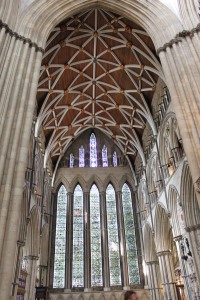
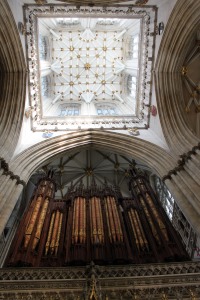



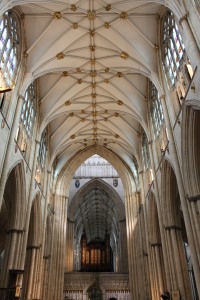

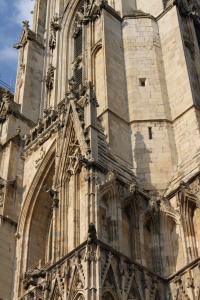

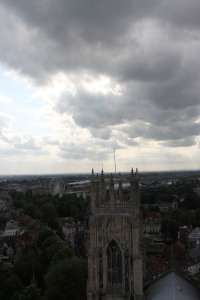


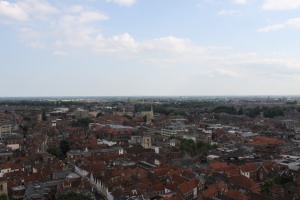

Your trip sounds amazing, I’m looking forward to seeing more photos! Did any of the exhibits at York Minster delve into the potential use of olive oil to protect the exterior?
Thanks! I will post more soon! I didn’t see any info there on the olive oil, but I have to admit that we were freaking exhausted by the time we got to the exhibit (we had climbed to the top of the central tower!!!) and I hadn’t seen your blog yet (I think maybe you wrote it after we had left York and headed to Scotland). I also didn’t realize until recently that my friend actually took her CLASS to York as part of a Castles and Cathedrals study abroad and they got to go up the scaffolding on the east facade (where they are restoring the famous window). She has some incredible pictures on Facebook. They got to hang out with the masons and sculptures who are recreating the original sculptures. Now I need to go back! 🙂